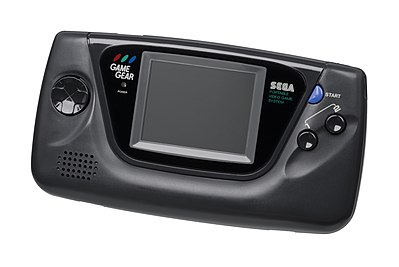Portal:Video games/Picture
Appearance


Game over screenshot from Mu-cade, a free, shooter game.
Photograph: Evan Amos
The Genesis Nomad is a handheld game console by Sega released in North America in October 1995. A portable variation of Sega's home console, the Sega Genesis, Nomad served to succeed the Game Gear and was the last handheld console released by Sega. In addition to functioning as a portable device, it was designed to be used with a television set via a video port. Released late in the Genesis era, the Nomad had a short lifespan and was sold exclusively in North America.

Eve Online booth and representative at Gen Con Indy 2007.

Ballistics Arcade on demonstration at the November 2002 IAAPA Convention.



Distribution map of video game content rating systems used around the world.

The WDR Radio Orchestra Cologne and the FILMharmonic Choir performing Symphonic Shades, part of a series of annual German video game music concerts.
The Game Gear is a handheld game console by Sega, released in various countries between 1990 and 1992. The Game Gear shares much of its hardware with the Master System, and can play Master System games through an adapter. Containing a full-color backlit screen with a landscape format, Sega positioned the Game Gear as a technologically superior handheld to the rival Game Boy but due to issues with its short battery life, lack of original titles, and weak support from Sega, the Game Gear was unable to beat the Game Boy. The Game Gear was succeeded by the Genesis Nomad in 1995 and discontinued in 1997. It sold approximately 11 million units.

Screenshot from Mystery House, a text-based adventure game.

Japanese musician Nobuo Uematsu is well known for his contributions to the music of the Final Fantasy series.

American journalist Brian Crecente is the former editor-in-chief of Kotaku, a video games focused blog, and founding editor of Polygon.




Three different multitaps released for the Sega's Mega Drive console. A multitap is a console peripheral that increases the number of game controller ports available.



Frank Klepacki, from his album Morphscape.

The Famicom Disk System, a peripheral available only for the Japanese Famicom.
Photograph: Evan Amos
The Mega Drive (top), known as the Sega Genesis (bottom) in North America, is a 16-bit home video game console developed and sold by Sega Enterprises, Ltd. Using hardware adapted from Sega's System 16 arcade board, it was first released in 1988 and supported a library of more than 900 games. Though sales were poor in Japan, the system achieved considerable success in North America, Brazil, and Europe. The release of the Super Nintendo Entertainment System two years after the Genesis resulted in a fierce battle for market share in the United States and Europe that has often been termed as a "console war" by journalists and historians.



Collection of Nintendo video game systems.



Collection of Sony PlayStation video game systems.

Exterior of the Los Angeles Convention Center displaying the Atari logo at the 2005 Electronic Entertainment Expo.

Dance Dance Revolution machine.
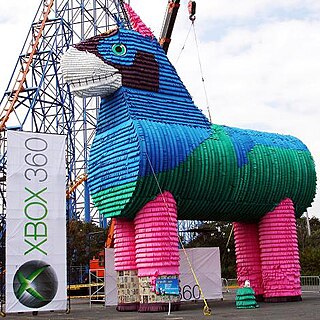
Large piñata of Horstacio, constructed in Six Flags México by Microsoft to promote the Xbox 360 game Viva Piñata.
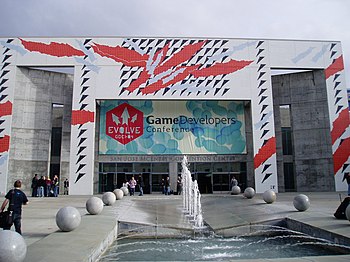
Outside the San Jose Convention Center at the 2004 Game Developers Conference.


Players using the dance pad to play Dance Dance Revolution at the 2008 Festival du Jeu Vidéo in Paris, France.

Exterior of the Retro Studios offices in Austin, Texas.
The SG-1000 is a cartridge-based home video game console manufactured by Sega. Introduced in 1983, it was developed in response to a downturn in arcades in 1982. Its game library comprises 68 standard cartridge releases and 29 Sega Card releases. The SG-1000 made little impact in the video game industry, but provided the basis for the more successful Master System in 1985.

Screenshot from The Splatters, a physics based puzzle game.

Staff of Telltale Games at the 2007 San Diego Comic-Con International.


A Commodore 64 computer.


"Final Fantasy XII Potions", a drink produced in Japan by Suntory Ltd. to promote the release of Final Fantasy XII.
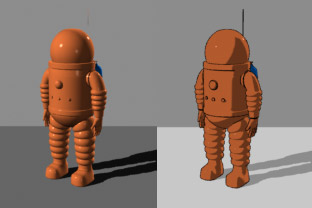
Different shading techniques, such as plastic-shaded (left) and cel-shaded (right), are used in the creation of 3D computer graphics in video games.

Holden Commodore Ute that toured Australia to promote Halo 2.
Carlos Borrego, winner of the Pac-Man World Championship in 2007.



Entrance to the 2008 Tokyo Game Show at the Makuhari Messe center.


Video game designer Robin Hunicke.

Atari VCS video game console with cartridge games.


Jerry Holkins and Mike Krahulik, authors of the Penny Arcade webcomic, founded the Child's Play charity and Penny Arcade Expo.



Screenshot from Laser Squad, a turn-based tactics game.

Shigeru Miyamoto at the 2007 Game Developers Conference.

Will Wright at the 2007 South by Southwest.

Ralph H. Baer receiving the National Medal of Technology from United States President George W. Bush in 2006.

Televised StarCraft video game competition.

Sony's PlayStation and PlayStation 2 consoles use memory cards to store game data. The PlayStation cards (left) can store 128 KB of data, while the PlayStation 2 cards (right) can store 8MB.
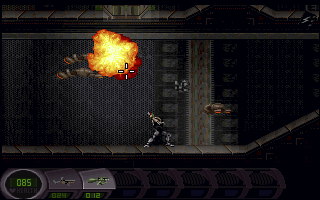
Screenshot from Abuse, a run and gun game.





PlayStation 2 guitar controllers for Guitar Hero.


The video game Portal features platforming puzzles that must be solved by teleporting.
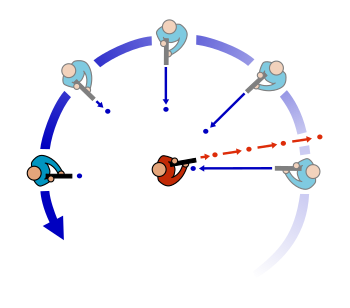
Circle strafing, a technique used in video games, particularly first-person shooters, to move around a target in a circle while facing it.
See also: animation
See also: animation






Square Enix's Lara Croft character has been portrayed by models (current model Alison Carroll pictured) for publicity events and promotions.

Production staff of Metal Gear Solid 4: Kenichiro Imaizumi, Yumi Kikuchi, and Hideo Kojima.

American game designer Chris Metzen is well known for his work on Blizzard Entertainment's three major media franchises: Warcraft, Diablo, and StarCraft.


German film director Uwe Boll has produced many film adaptions of video games.



1998 employees of Neversoft.

Johnathan Wendel (Fatal1ty) at the 2007 COMPUTEX Taipei.

The original Xbox controller (left) and the Controller S version (right).

Mattel's Intellivision video game console was released in 1979.

Ralph H. Baer's prototype for the Magnavox Odyssey, also known as the "Brown Box", at the Museum of Science and Industry in Chicago, Illinois.

The Nintendo GameCube is capable of connecting with Game Boy hardware: Game Boy Player, Game Boy Advance, and Game Boy Advance SP.




NEC's PC Engine video game console, originally released in Japan in 1987, was released in the United States as the TurboGrafx-16 in 1989.


